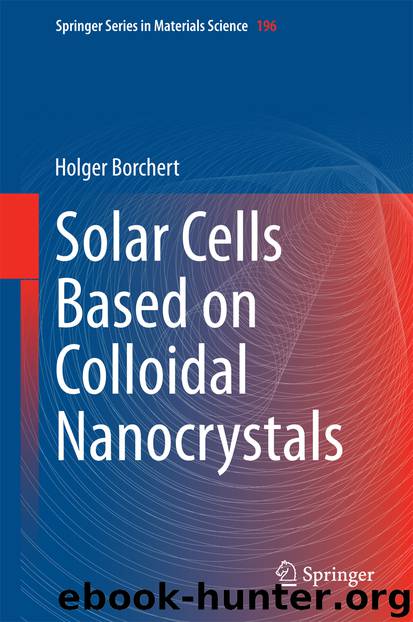Solar Cells Based on Colloidal Nanocrystals by Holger Borchert

Author:Holger Borchert
Language: eng
Format: epub
Publisher: Springer International Publishing, Cham
Also shown in Fig. 8.2 are PL spectra of films made of donor/acceptor systems when blending the polymer with CdSe nanocrystals or PCBM as electron acceptor, respectively. In both cases, the PL intensity is reduced (said to be “quenched”). This can be interpreted as an indication that charge transfer is possible at the material interface, because after electron transfer to the acceptor, the electron can obviously no longer recombine radiatively from the LUMO level of the donor polymer. Thus, PL quenching is a useful tool to probe charge transfer processes in donor/acceptor solar cells. However, care must be taken in the interpretation, because under certain conditions, the PL intensity can also be reduced by processes concurring with charge transfer. If the acceptor material has a lower energy gap than the donor, it is also possible that the entire electron–hole pair is transferred to the acceptor by Förster resonance energy transfer (FRET). If this is possible, it becomes difficult to distinguish between both processes in simple PL quenching experiments.
Download
This site does not store any files on its server. We only index and link to content provided by other sites. Please contact the content providers to delete copyright contents if any and email us, we'll remove relevant links or contents immediately.
Alchemy and Alchemists by C. J. S. Thompson(3422)
The Elements by Theodore Gray(2953)
The Club by A.L. Brooks(2812)
How to Make Your Own Soap by Sally Hornsey(2791)
Drugs Unlimited by Mike Power(2515)
Wheels of Life by Anodea Judith(1956)
Cracking the Sat French Subject Test, 2013-2014 Edition by The Princeton Review(1801)
Perfume by Jean-Claude Ellena(1765)
Cracking the LSAT, 2012 Edition by Princeton Review(1762)
The Flavor Matrix by James Briscione(1744)
The Cosmic Machine: The Science That Runs Our Universe and the Story Behind It by Scott Bembenek(1712)
MCAT Physics and Math Review by Princeton Review(1611)
1000 Multiple-Choice Questions in Organic Chemistry by Organic Chemistry Academy(1590)
The Thing Around Your Neck by Chimamanda Ngozi Adichie(1553)
Handbook of Modern Sensors by Jacob Fraden(1521)
Cracking the SAT Premium Edition with 6 Practice Tests, 2017 by Princeton Review(1505)
Synchrotron Light Sources and Free-Electron Lasers by Eberhard J. Jaeschke Shaukat Khan Jochen R. Schneider & Jerome B. Hastings(1503)
A is for Arsenic: The Poisons of Agatha Christie (Bloomsbury Sigma) by Kathryn Harkup(1480)
Harry Potter All Books: 8 Books by J.k.rowling(1459)
